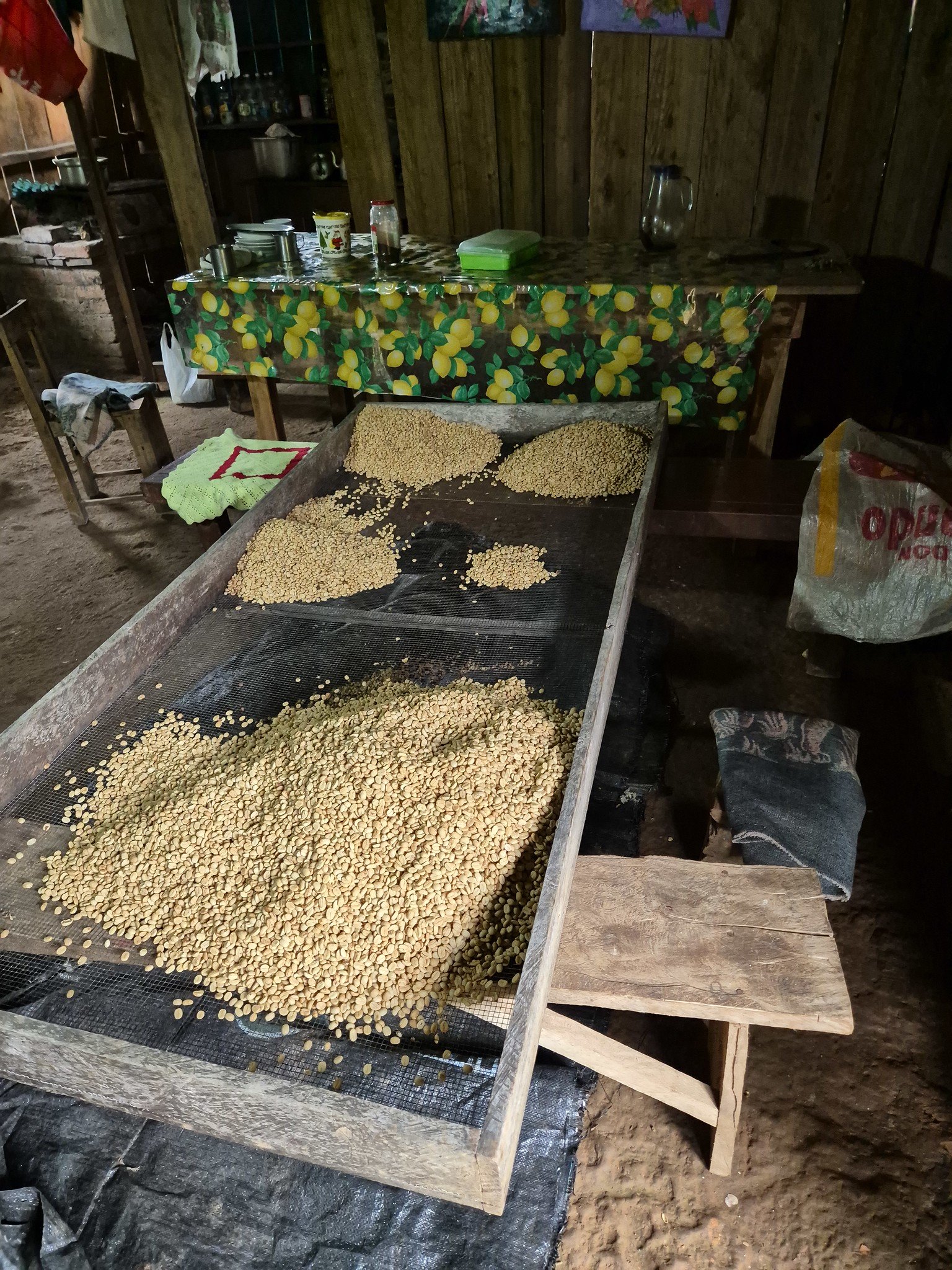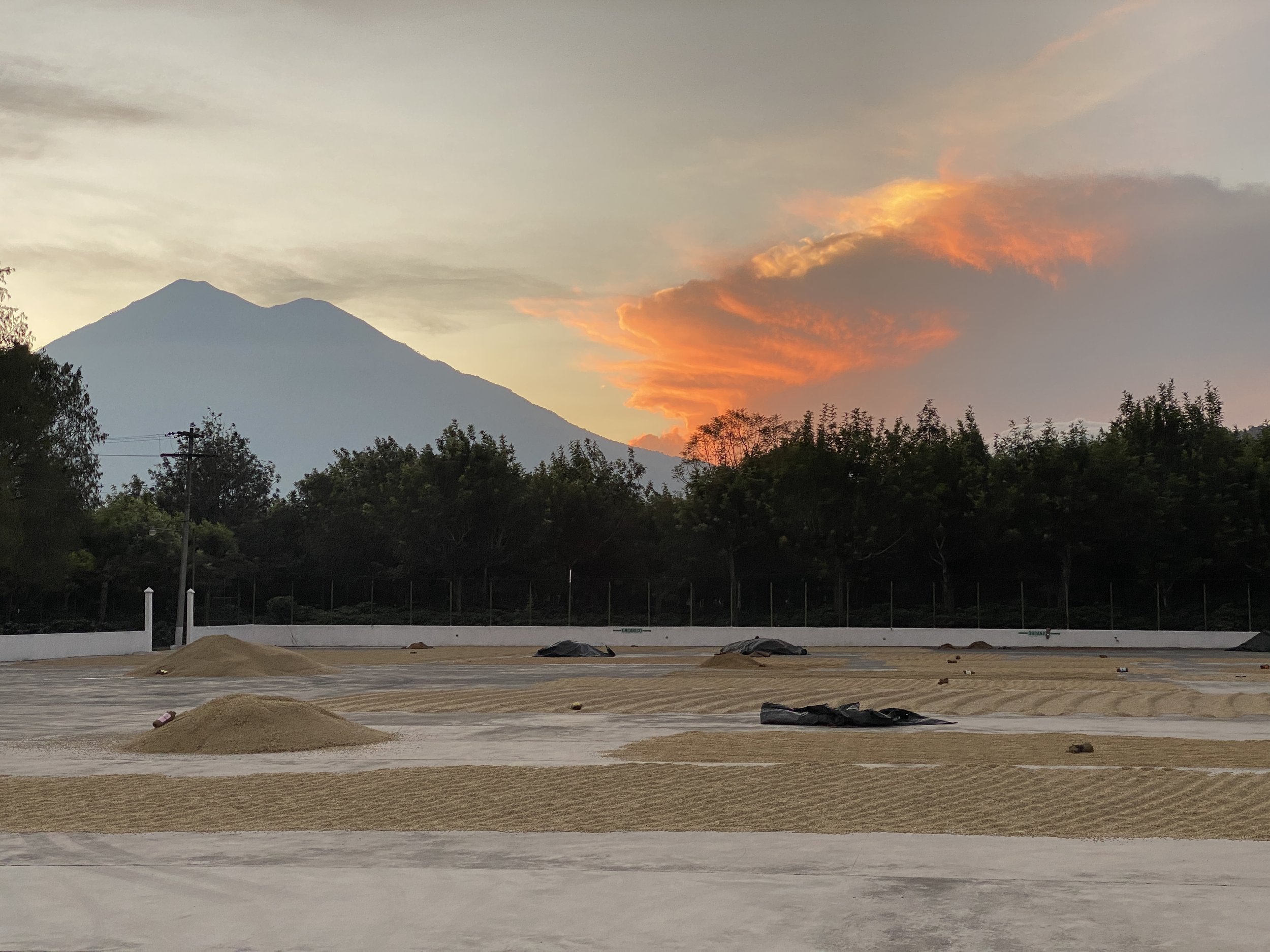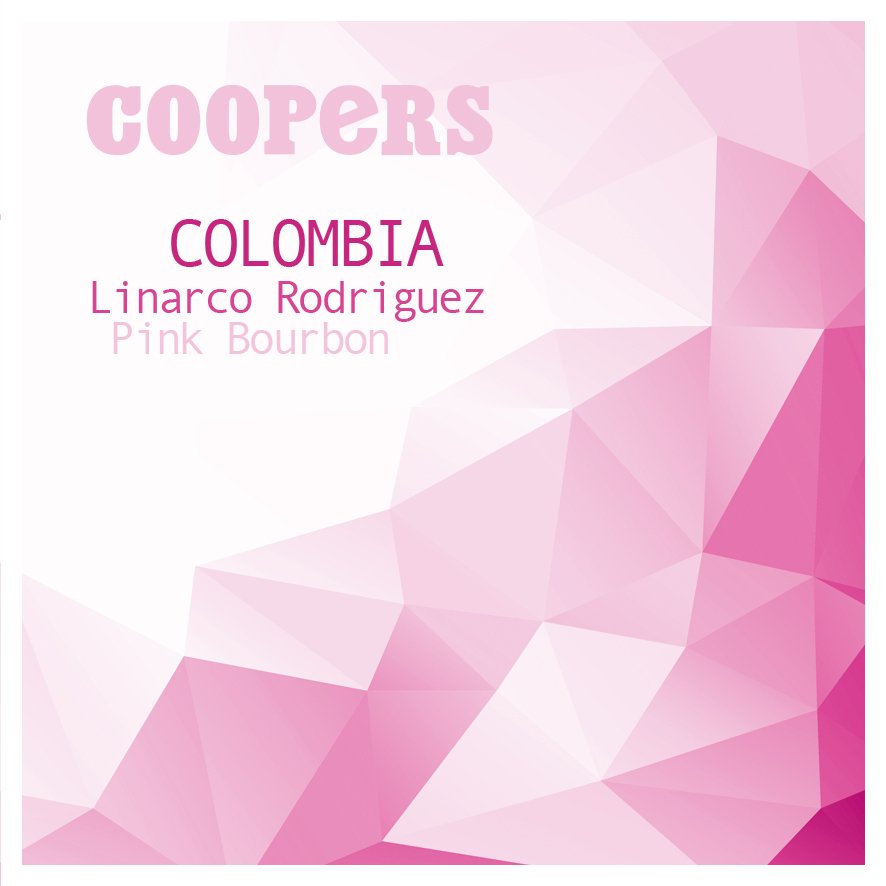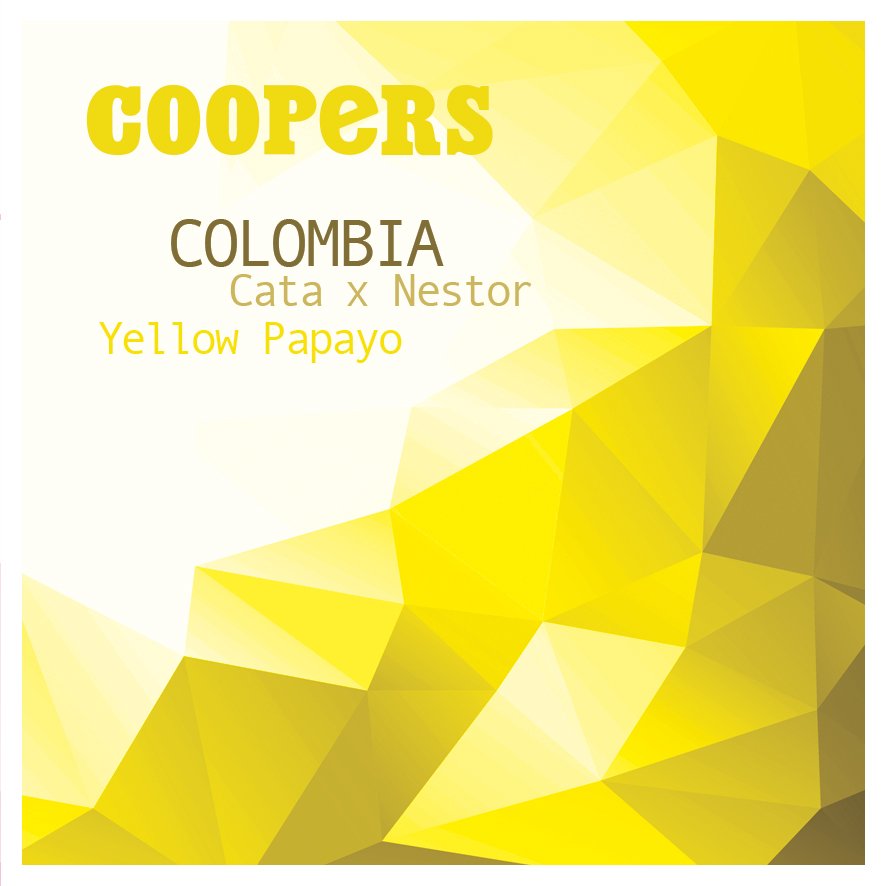 Image 1 of 5
Image 1 of 5

 Image 2 of 5
Image 2 of 5

 Image 3 of 5
Image 3 of 5

 Image 4 of 5
Image 4 of 5

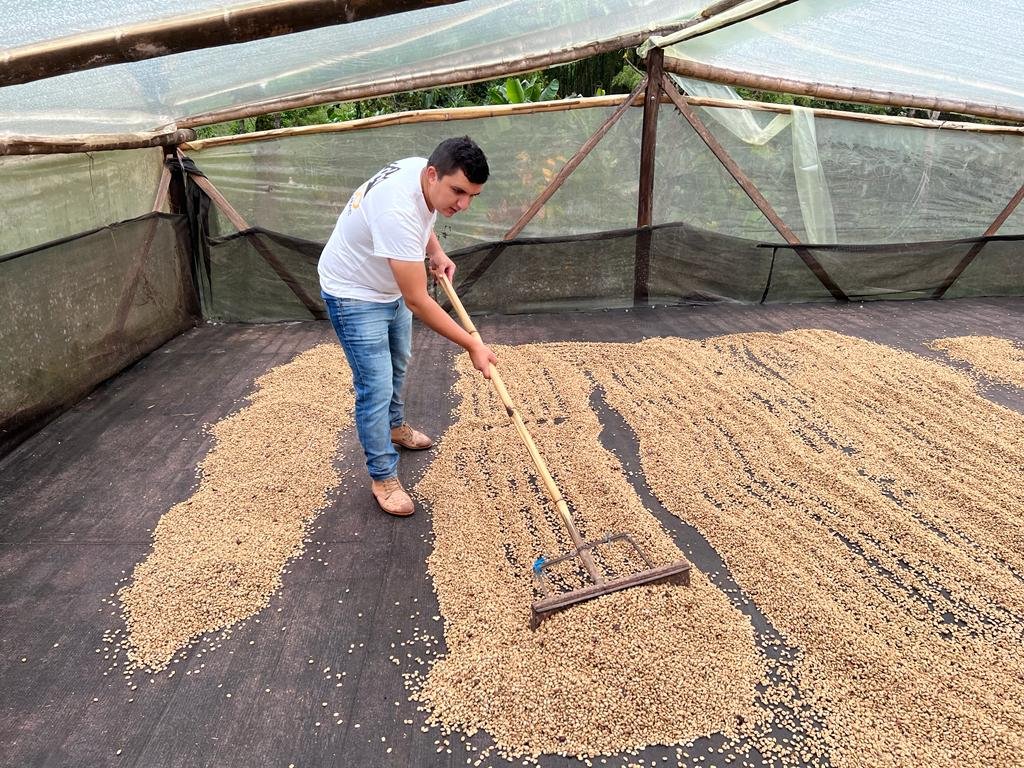 Image 5 of 5
Image 5 of 5






Colombian - CATA x NESTOR Yellow Papayo Natural
ORIGIN: COLOMBIA
FARM: EL DIVISO
REGION: HUILA - Bruselas
ALTITUDE: 1850 MSL
AREA: 14 1⁄2HECTARESSHADE: NATIVE AND FRUITS TREES
250g
Information about this Coffee:
A unique collaboration to celebrate years of friendship and hard work towards coffee excellence.
Nestor Lasso and El Diviso are now household names that need no introduction, but do you really know how it all began?
When CATA was founded in 2019 with the fixed idea to discover new and talented producers who could elevate the quality of Colombian coffees, Cat and Pierre spent the little savings they had on an old pick up truck and travelled throughout Colombia literally knocking on farm doors asking producers if they had specialty coffee. Although the task was daunting, their adventurous and bold method led them to the town of Bruselas, Huila to connect with producer Henry Bonilla who had just launched the specialty program of a local coop. During a cupping session with Henry, Cat spotted a young kid who was sample roasting his coffee experiments and looking at her, amazed to see someone from Bogota and a foreigner in his town. That young and shy kid was Nestor. Nestor came up to Cat and Pierre and asked them to cup his coffees, it wasn’t anything outstanding an 86 scoring semi-washed pink bourbon a bit dirty around the edges, but Cat really liked the kindness and soft personality of Nestor and decided that she would do her very best to promote his coffees, at that time he was only 18 years old.
CATA started exporting El Diviso’s first lots to Europe and the same time using the profits made to bank roll Nestor's experiments and even funded the refurbishment of his solar dryers at the time where Cat and Pierre couldn’t even afford to pay rent. But little by little the results were showing in the cup and after a few years the Pink Bourbon Natural 180H was born.
When Cat and Pierre first cupped this coffee they knew they had a winner, so they started lobbying amongst all coffee competitors in Europe to see who would compete with this coffee but because no one knew Nestor no one wanted to take a chance on him. Cat and Pierre continued looking and finally Keith Blackburn from New Kid coffee in Ireland took his chance and won Brewers Cup in 2022. From there competitors started asking CATA for Nestor Lasso competition lots, gradually making it a regular on SCA nationals podiums in Europe and it wasn’t long until the word got out to the rest of the world. Thanks to this hard-earned fame, Nestor was able to continue his R&D and soon the Sidra Natural was born, an improved processing method inspired by the 180H.
Later that year, CATA exported a 10KG type sample to Korea, and as fate would have it, that coffee landed in the hands of Axil and Anthony Douglas, and the rest is history.
In 2019, Nestor Lasso and his brother Adrian took over the family farm and branched out into specialty coffee and experimentation rather than growing coffee like their parents. Today, at 23 and 25, the two brothers have teamed up with Jhoan Vergara, also the child of a coffee farmer, to create El
Diviso. El Diviso brings together the two-family farms, El Diviso (Nestor and Adrian Lasso) and Las Flores (Jhoan Vergara), close to the town of Pitalito, in the Huila region of Colombia. This partnership was great as these 3 young guys united their knowledge to improve quality.
At the same time, Cat & Pierre, founders of CATA Export and the 3 producers started a journey of trial and error to define the fermentation processes and protocols at the farm, with the aim to link these coffees directly to the UK market. This learning process has been time and money consuming but with an exciting outcome as today these coffees have been used in many barista competitions across Europe. Recently winning 1st place at Brewers Cup in Ireland and 3rd in Austria.
Today Cata Export and Finca El Diviso work as one team, the reason why Cat is not alone in this trip to the UK but with Nestor to finally meet all the roasteries who have been behind this process too. Nestor’s and Cat’s friendship is a good example of what Cata Export do, working directly from the farms is a very enriching process for them not only for the
complexity of topics such as agronomy but also for the relationships Cata builds which ultimately translate into an economic benefit for Cata’s community, in this way many more young producers like Nestor have stayed in coffee and have had the chance to build a career.
NESTOR’S WORDS:
I grew up in a vereda (locality, editor's note.) called Normandia, near the town of Pitalito in the south of the Huila region. I always grew up on the farm and since I can remember the region has always been a coffee zone.
Here I had a very healthy childhood, everyone knows each other and it's safe. The memories I have of my childhood are of playing in nature, playing hide and seek and I have always been super happy to be here.
In general, being a coffee producer is poorly paid and it is not very attractive. The only thing that allows producers not to starve is to eat the fruits and vegetables produced on the farm. In terms of material goods, we only have access to what is strictly necessary. Many young people therefore prefer to go to town to find an office job or a less physically demanding job because they think that the coffee is not worth it.
Beyond what specialty coffee brings economically, I have always had a passion for production. When I realized that specialty coffee offered a real possibility of economic development, and that in addition I could develop my knowledge of coffee production, and in particular the processes, I really got into it.
I understand more or less how the market works due to the close partnership we have with Cat and Pierre but also social networks allow us to see who is buying our coffees. They also allow us to see how specialty coffee is marketed in Europe.
Cat told me the importance of the sensory side of the business and she encouraged me to learn to cup to control the quality
of what is produced and to understand the impact of the processes and whether they improve or not in the cup.
Also, in Colombia there is a program we followed funded by the Colombian state and today this program is recognized as the best coffee growing school in Latin America, called SENA.
We learned a lot at SENA, me and my brother. All the theoretical bases, the science of coffee processing... everything is taught there. But the reality of the job of coffee producer is learned in the field.
We must not forget that the price of coffee is very high at the moment reason why lot of producers want to know how we work, but we quickly identify people who are really motivated to produce specialty coffee, who come to ask us questions to learn with us and those who only see it as a temporary opportunity to earn money.
What really makes the difference is the passion that the producer can have for the coffee. If you're not naturally passionate, you'll never get the trick!
Often, some coffee growers here have a lot of money because they have a lot of land and the best machines possible. But specialty coffee does not interest them, they do not see the point of changing because they are not as passionate about coffee as we are.
I have seen that specialty coffee consumption has changed a lot in recent years in the country. Until recently, Colombians only drank coffee by-products, anything that could not be
exported. But people here have realised that coffee is a much more noble product than it seems. Many producers today keep part of their harvest to roast it themselves and drink it at home. All the specialty coffee craze has really brought about a different way of looking at coffee.
PROCESS + DETAILS
● STEP1.THECHERRIESAREPICKEDATOPTIMALMATURITY
STAGE, WITH BRIX DEGREES RANGING BETWEEN 21 - 24
DEGREES.
● STEP 2. THE CHERRIES ARE PUT INTO OPEN PLASTIC TANKS
AND ARE LEFT OXIDISING FOR 48 HOURS. DURING THESE 48H,
THE COFFEE MUST (JUICE OR EXTRACT PRODUCED DURING
THE OXIDATION) IS CONSTANTLY BEING RECIRCULATED. THE
COFFEE MUST IS MONITORED AND ANALYSED TO MAKE SURE
THAT IT IS AT 19 BRIX DEGREES AND THAT THE PH DOESN’T
FALL UNDER 5.
● STEP3.ALLTHECHERRIESAREEMPTIEDINATANKOFCOLD
WATER AND THE ONES THAT STAY AFLOAT (UNRIPE, LOWER
DENSITY, BROCA INFECTED ETC...) ARE MANUALLY REMOVED.
● STEP4.THECHERRIESARETHENRINSEDWITHWATERHEATED
AT 50° C (THERMAL SHOCK) TO LOOSEN THEIR MOLECULAR
STRUCTURE AND KICKSTART THE FERMENTATION PROCESS
BEFORE BEING TRANSFERRED INTO AIRTIGHT PLASTIC BINS TO
ANDSTART THEIR ANAEROBIC PROCESS.
BEFORE CLOSING THE LID OF THE TANK, BREWERS’ YEAST IS
SPRAYED ON THE CHERRIES AT A RATIO OF 1:5 (1 GR YEAST /
5KG CHERRIES) DILUTED IN 32°C WATER .
THE CHERRIES ARE LEFT FERMENTING FOR 38 HOURS WHILST
ENDEMIC MICROORGANISMS AND THE ADDED YEAST
MULTIPLY.
● STEP5.THECHERRIESARETHENMECHANICALLYDRIEDFOR
APPROXIMATELY 12 HOURS TO DEHYDRATE AS FAST AS
POSSIBLE AND REACHED 18% MOISTURE CONTENT.
● STEP6.THECHERRIESAREPLACEDINCLOSEDPLASTICBAGS
AND LEFT TO STABILISE FOR 2 DAYS IN A DARK ROOM.
● STEP7.THECHERRIESAREPLACEDINMARQUESINASTO
FINISH THE DRYING PROCESS FOR APPROXIMATELY 15 DAYS
UNTIL REACHING 10.5-11.5% MOISTURE CONTENT.
ORIGIN: COLOMBIA
FARM: EL DIVISO
REGION: HUILA - Bruselas
ALTITUDE: 1850 MSL
AREA: 14 1⁄2HECTARESSHADE: NATIVE AND FRUITS TREES
250g
Information about this Coffee:
A unique collaboration to celebrate years of friendship and hard work towards coffee excellence.
Nestor Lasso and El Diviso are now household names that need no introduction, but do you really know how it all began?
When CATA was founded in 2019 with the fixed idea to discover new and talented producers who could elevate the quality of Colombian coffees, Cat and Pierre spent the little savings they had on an old pick up truck and travelled throughout Colombia literally knocking on farm doors asking producers if they had specialty coffee. Although the task was daunting, their adventurous and bold method led them to the town of Bruselas, Huila to connect with producer Henry Bonilla who had just launched the specialty program of a local coop. During a cupping session with Henry, Cat spotted a young kid who was sample roasting his coffee experiments and looking at her, amazed to see someone from Bogota and a foreigner in his town. That young and shy kid was Nestor. Nestor came up to Cat and Pierre and asked them to cup his coffees, it wasn’t anything outstanding an 86 scoring semi-washed pink bourbon a bit dirty around the edges, but Cat really liked the kindness and soft personality of Nestor and decided that she would do her very best to promote his coffees, at that time he was only 18 years old.
CATA started exporting El Diviso’s first lots to Europe and the same time using the profits made to bank roll Nestor's experiments and even funded the refurbishment of his solar dryers at the time where Cat and Pierre couldn’t even afford to pay rent. But little by little the results were showing in the cup and after a few years the Pink Bourbon Natural 180H was born.
When Cat and Pierre first cupped this coffee they knew they had a winner, so they started lobbying amongst all coffee competitors in Europe to see who would compete with this coffee but because no one knew Nestor no one wanted to take a chance on him. Cat and Pierre continued looking and finally Keith Blackburn from New Kid coffee in Ireland took his chance and won Brewers Cup in 2022. From there competitors started asking CATA for Nestor Lasso competition lots, gradually making it a regular on SCA nationals podiums in Europe and it wasn’t long until the word got out to the rest of the world. Thanks to this hard-earned fame, Nestor was able to continue his R&D and soon the Sidra Natural was born, an improved processing method inspired by the 180H.
Later that year, CATA exported a 10KG type sample to Korea, and as fate would have it, that coffee landed in the hands of Axil and Anthony Douglas, and the rest is history.
In 2019, Nestor Lasso and his brother Adrian took over the family farm and branched out into specialty coffee and experimentation rather than growing coffee like their parents. Today, at 23 and 25, the two brothers have teamed up with Jhoan Vergara, also the child of a coffee farmer, to create El
Diviso. El Diviso brings together the two-family farms, El Diviso (Nestor and Adrian Lasso) and Las Flores (Jhoan Vergara), close to the town of Pitalito, in the Huila region of Colombia. This partnership was great as these 3 young guys united their knowledge to improve quality.
At the same time, Cat & Pierre, founders of CATA Export and the 3 producers started a journey of trial and error to define the fermentation processes and protocols at the farm, with the aim to link these coffees directly to the UK market. This learning process has been time and money consuming but with an exciting outcome as today these coffees have been used in many barista competitions across Europe. Recently winning 1st place at Brewers Cup in Ireland and 3rd in Austria.
Today Cata Export and Finca El Diviso work as one team, the reason why Cat is not alone in this trip to the UK but with Nestor to finally meet all the roasteries who have been behind this process too. Nestor’s and Cat’s friendship is a good example of what Cata Export do, working directly from the farms is a very enriching process for them not only for the
complexity of topics such as agronomy but also for the relationships Cata builds which ultimately translate into an economic benefit for Cata’s community, in this way many more young producers like Nestor have stayed in coffee and have had the chance to build a career.
NESTOR’S WORDS:
I grew up in a vereda (locality, editor's note.) called Normandia, near the town of Pitalito in the south of the Huila region. I always grew up on the farm and since I can remember the region has always been a coffee zone.
Here I had a very healthy childhood, everyone knows each other and it's safe. The memories I have of my childhood are of playing in nature, playing hide and seek and I have always been super happy to be here.
In general, being a coffee producer is poorly paid and it is not very attractive. The only thing that allows producers not to starve is to eat the fruits and vegetables produced on the farm. In terms of material goods, we only have access to what is strictly necessary. Many young people therefore prefer to go to town to find an office job or a less physically demanding job because they think that the coffee is not worth it.
Beyond what specialty coffee brings economically, I have always had a passion for production. When I realized that specialty coffee offered a real possibility of economic development, and that in addition I could develop my knowledge of coffee production, and in particular the processes, I really got into it.
I understand more or less how the market works due to the close partnership we have with Cat and Pierre but also social networks allow us to see who is buying our coffees. They also allow us to see how specialty coffee is marketed in Europe.
Cat told me the importance of the sensory side of the business and she encouraged me to learn to cup to control the quality
of what is produced and to understand the impact of the processes and whether they improve or not in the cup.
Also, in Colombia there is a program we followed funded by the Colombian state and today this program is recognized as the best coffee growing school in Latin America, called SENA.
We learned a lot at SENA, me and my brother. All the theoretical bases, the science of coffee processing... everything is taught there. But the reality of the job of coffee producer is learned in the field.
We must not forget that the price of coffee is very high at the moment reason why lot of producers want to know how we work, but we quickly identify people who are really motivated to produce specialty coffee, who come to ask us questions to learn with us and those who only see it as a temporary opportunity to earn money.
What really makes the difference is the passion that the producer can have for the coffee. If you're not naturally passionate, you'll never get the trick!
Often, some coffee growers here have a lot of money because they have a lot of land and the best machines possible. But specialty coffee does not interest them, they do not see the point of changing because they are not as passionate about coffee as we are.
I have seen that specialty coffee consumption has changed a lot in recent years in the country. Until recently, Colombians only drank coffee by-products, anything that could not be
exported. But people here have realised that coffee is a much more noble product than it seems. Many producers today keep part of their harvest to roast it themselves and drink it at home. All the specialty coffee craze has really brought about a different way of looking at coffee.
PROCESS + DETAILS
● STEP1.THECHERRIESAREPICKEDATOPTIMALMATURITY
STAGE, WITH BRIX DEGREES RANGING BETWEEN 21 - 24
DEGREES.
● STEP 2. THE CHERRIES ARE PUT INTO OPEN PLASTIC TANKS
AND ARE LEFT OXIDISING FOR 48 HOURS. DURING THESE 48H,
THE COFFEE MUST (JUICE OR EXTRACT PRODUCED DURING
THE OXIDATION) IS CONSTANTLY BEING RECIRCULATED. THE
COFFEE MUST IS MONITORED AND ANALYSED TO MAKE SURE
THAT IT IS AT 19 BRIX DEGREES AND THAT THE PH DOESN’T
FALL UNDER 5.
● STEP3.ALLTHECHERRIESAREEMPTIEDINATANKOFCOLD
WATER AND THE ONES THAT STAY AFLOAT (UNRIPE, LOWER
DENSITY, BROCA INFECTED ETC...) ARE MANUALLY REMOVED.
● STEP4.THECHERRIESARETHENRINSEDWITHWATERHEATED
AT 50° C (THERMAL SHOCK) TO LOOSEN THEIR MOLECULAR
STRUCTURE AND KICKSTART THE FERMENTATION PROCESS
BEFORE BEING TRANSFERRED INTO AIRTIGHT PLASTIC BINS TO
ANDSTART THEIR ANAEROBIC PROCESS.
BEFORE CLOSING THE LID OF THE TANK, BREWERS’ YEAST IS
SPRAYED ON THE CHERRIES AT A RATIO OF 1:5 (1 GR YEAST /
5KG CHERRIES) DILUTED IN 32°C WATER .
THE CHERRIES ARE LEFT FERMENTING FOR 38 HOURS WHILST
ENDEMIC MICROORGANISMS AND THE ADDED YEAST
MULTIPLY.
● STEP5.THECHERRIESARETHENMECHANICALLYDRIEDFOR
APPROXIMATELY 12 HOURS TO DEHYDRATE AS FAST AS
POSSIBLE AND REACHED 18% MOISTURE CONTENT.
● STEP6.THECHERRIESAREPLACEDINCLOSEDPLASTICBAGS
AND LEFT TO STABILISE FOR 2 DAYS IN A DARK ROOM.
● STEP7.THECHERRIESAREPLACEDINMARQUESINASTO
FINISH THE DRYING PROCESS FOR APPROXIMATELY 15 DAYS
UNTIL REACHING 10.5-11.5% MOISTURE CONTENT.
What makes this special

Tasting Notes
JUICY
Sweet and well rounded
Strawberry, fruit pastilles, kiwi notes

Origin
HUILA REGION- Bruselas
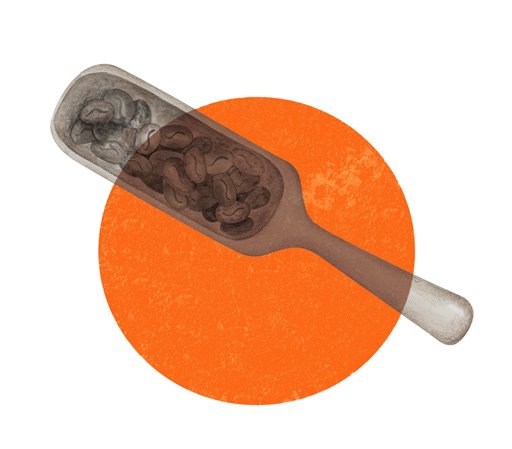
Process
Natural

Owner
Nestor Lasso and El Diviso





